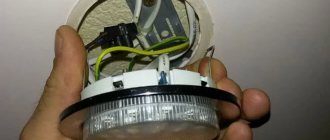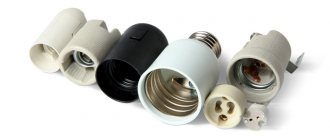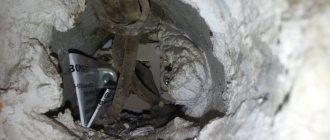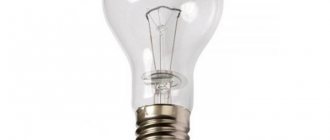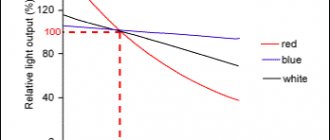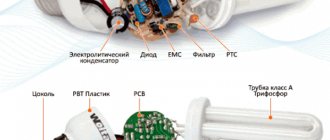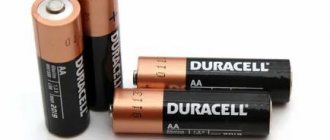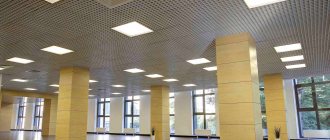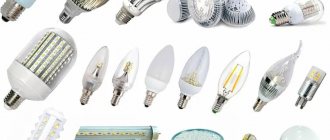Traditional incandescent lamps (LON)
A device of this type consists of a base where the contacts are located, a fuse, an incandescent element and a glass cylinder.
The spiral is usually made of an alloy with tungsten, which can withstand a high combustion temperature of +3200 °C for a long time. To extend the burnout time, the cylinder is filled with argon or other inert gas; in some devices, on the contrary, they create a vacuum.
To operate the lamp, electric current is passed through a conductor that has a small cross-section and a low degree of conductivity. The energy heats up the spiral, which emits light waves.
Various types of lamps are used to illuminate rooms, the choice of which depends on the purpose of the light source, the required brightness and other criteria.
There is a huge variety of general purpose light bulbs, or LON for short: regular size or miniature for local lighting.
According to the type of design, the flask can be:
- painted;
- frosted glass;
- mirror
Modifications of LON can have flasks not only with colorless glass, but also with multi-colored transparent glass. As a rule, they are used for decorative purposes.
Models with frosted glass cylinders are in demand, providing soft, uniform light, which is especially suitable for lighting bedrooms and children's rooms.
The most advanced models of this type are krypton, bispiral lamps, which have improved characteristics. However, they are inferior in quality to other categories of lighting fixtures
For mirror devices, part of the cylinder is coated with a special compound that reflects light, directing it in a narrow stream.
Such devices are often inserted into ceiling lamps, since they allow light to be cast only downward, without illuminating or heating the upper surface.
Bulbs operating on voltages of 12, 24, 36 V require minimal electricity consumption, but produce a very dim, weak light. They are used in flashlights or for emergency lighting.
Technical characteristics of LON:
- luminous efficiency - 9-19 Lm/W;
- power - 25-150 Watt;
- the average operating period is one thousand hours at a voltage of 220 V;
- Efficiency – less than 30%.
The advantages include low price, simple and accessible installation for everyone, pleasant yellowish lighting light.
Incandescent appliances have significantly more disadvantages: they are fragile, quickly burn out during voltage surges, and in addition, their surface becomes very hot, which can cause a fire.
There is an article on our website in which we described in detail the types of incandescent lamps, their labeling, and also outlined the main criteria for their selection. For more details, follow the link.
The future of lighting
LEDs are one of the most promising areas for the development of lighting technologies: due to their unique characteristics, the possibilities for using LEDs are almost limitless.
Given the rapid development of technological progress, it is now difficult to imagine what home lighting will be like, for example, in a hundred years. Assuming that current trends are reflected in the apartments of the future, lighting will be energy efficient, dynamic, and will make maximum use of and complement natural light. Thanks to LED and OLED technologies (organic light-emitting diodes), any surface can serve as light sources: furniture, walls, floors, clothing. For example, Philips luminous wallpapers are already available, they create the feeling that the entire wall is illuminated, and its light modes can change. So, in the morning they can shine with a pleasant white light, and in the evening they can surprise you with a play of shades. OLED plates will be able to replace window glass, which during daylight hours will let in daylight and serve as transparent glass, and at night the thinnest panels will imitate a sunset, dawn or sunny morning.
Variety of halogen light sources
This type of device with a base has a design similar to incandescent lamps, but instead of an inert gas, the bulb is filled with compounds of iodine, bromine or other halogens. This allows you to reduce evaporation of the heating element, as well as increase its temperature.
Halogen products emit an intense stream of light rays in a color that is pleasing to the eye. They are often used to illuminate and highlight individual interior details.
In addition to base lamps, other options have become widespread, for example, linear halogen lamps, which have the shape of a tube. Impact-resistant models with intense light are used for street floodlights.
Capsule low-voltage devices with miniature dimensions are popular. They are often used for chandeliers or suspended ceilings, but the connection to the network must be done through a special transformer.
Another type is reflective devices, the design of which uses a special reflector - most often an aluminum disk. It allows you to adjust the angle of incidence of the light beam, directing it to the desired area of the room.
Such devices are used to install ceiling lamps, since they eliminate heating of the upper surface.
Technical characteristics of halogen lamps:
- power - 1-20 W;
- color rendering index - 100%;
- flask heating – 500 °C;
- light output - 15-22 Lm/W;
- operates in the range from -60 to +100 °C;
- service life - 2000-4000, when using a transformer up to 8000 hours;
- Efficiency – 50-80%.
Among the advantages of this category of devices are a fairly long service life, as well as the ability to manufacture miniature models that produce bright light.
They have excellent color rendering, and modern technology can give the radiance emitted both a warm and cool shade.
Halogen devices can be high or low voltage. In the first case, they are powered directly from the network, in the second, they should be connected via a transformer
The disadvantages include strong heating of the surface of the flask, which is why it is made of heat-resistant quartz glass. But even in this case, it is not recommended to allow them to come into contact with the ceiling or walls of the lamp.
Halogen lamps are very sensitive to dirt - touching them with bare hands can cause the bulb to burn out or even disintegrate. They also do not tolerate power surges well.
Read about how to choose a good halogen lamp in this material.
Fluorescent lamps (CFL and LL)
The devices consist of a bulb, the inner surface of which is coated with a phosphor. The container containing the electrodes is filled with a mixture of mercury vapor and inert gas.
For starting, a special unit is used - electronic or mechanical ballast. When turned on, a charge is sent inside the flask, which causes the formation of ultraviolet waves, under the influence of which the phosphor begins to glow evenly.
Fluorescent lamps can emit light of different shades. Various markings are used to designate it. As an example, we can call LTB - warm light lamp, LHB - cold light, LE - natural light
Models are divided into two types:
- linear devices (LL) - bulky tubes with two pins at the ends;
- compact lamps (CFLs), which have the appearance of a twisted spiral, in which the starting unit is hidden in the base.
The marking G indicates devices with a pin design, and the letter E indicates a threaded cartridge.
Technical characteristics of CFL:
- light output - 40-80 Lm/W;
- power - 15-80 Watt;
- service period - 10,000-40,000 hours.
An important advantage of luminescents is their low operating temperature. Even when the product is turned on, you can safely touch it with your bare hand, making it safe to install on any surface.
At the same time, such devices have many negative sides. First of all, they are not environmentally friendly enough - the mercury vapor inside is poisonous.
Although they are not harmful to humans in a closed bulb, broken or burnt out bulbs can pose a danger. Because of this, they require a recycling procedure: used products must be taken to recycling points, which are not always easy to find.
Fluorescent devices consume significantly less electricity than incandescent lamps, they have a long service life and good light output
Other disadvantages include:
- Unstable operation at low temperatures. At -10 °C, even powerful devices shine extremely dimly.
- When turned on, the lamps do not light up immediately, but after a few seconds or minutes.
- Their cost is quite high.
- Operation may be accompanied by a low-frequency hum.
- Such models are difficult to compatible with dimmers, which makes it difficult to adjust the light intensity. It is also undesirable to use them together with switches that have backlight indicators.
- Although the service life is quite long, it is significantly shortened if it is turned on and off frequently.
In addition, the light emitted by these devices pulsates strongly, which tires the eyes.
You can read more about the design of fluorescent lamps, their advantages and disadvantages here.
Socles
Plinths come in different types and designs. Labeling will help you understand which one is which.
The first letter indicates the type of base. In home lighting the following are mainly used:
- E – threaded base (Edison)
- G – pin base
The number in the base designation indicates the diameter of the connecting part or the distance between the pins.
Lowercase letters at the end indicate the number of contact plates, pins or flexible connections (only for some types):
- s – one contact
- d – two contacts
Sometimes another qualifying letter U is added to the first letter, indicating an energy-saving lamp.
LED lamps for home lighting have standard sockets that fit most sockets used in everyday life.
Threaded base E (Edison)
The E10 base is the smallest of the threaded bases. Can be used in Christmas tree garlands or in pocket flashlights.
Base E14 - the so-called minions, are most often used in small lamps, sconces and chandeliers. Modern LED lamps are also manufactured in such a base; they can replace any standard incandescent lamp, this will significantly save energy. Light bulbs for such a socket are distinguished by a wide variety of types: pear-shaped, candle-shaped, teardrop-shaped, spherical, mirror and others.
E27 socket - lighting fixtures with this socket are the most common; they fit standard sockets that are installed in every room. LED lamps with such a base are as close as possible to standard and familiar incandescent lamps; they will fit any lamp with a similar socket.
Pin sockets
Base GU10 – has thickenings at the ends of the contacts for rotating connection with the cartridge. Standard ceiling lamps have this type of base.
The GU5.3 base is most often found in halogen incandescent lamps MR16. This base is for accent lighting, in furniture lamps, in suspended and suspended ceilings. LED lamps with such a base are represented in a fairly wide range, so they can fully replace halogen lamps.
Light-emitting diode (LED) lamps
The design of diode light bulbs is based on semiconductor crystals, which, as a result of a pn junction, emit light rays.
As a rule, they involve at least five diodes, which are connected to the installation board. Operation occurs using a driver that converts alternating current into direct current.
The lamps practically do not heat up during operation, since they have special parts - radiators - to remove heat. Depending on the modification, the devices are equipped with screw or pin sockets.
Using LED elements you can create attractive compositions on stretch/suspended ceilings. The design made from lamps of different colors looks especially impressive.
Types of LEDs include filament devices. Outwardly, they resemble ordinary incandescent lamps, but instead of a spiral, they are equipped with semiconductor elements strung on a rod, which is placed in a flask with an inert gas.
In order for such a device to be screwed into the cartridge, it is supplemented with a traditional threaded base. Such models allow you to combine retro design with higher technical characteristics, such as energy efficiency, durability, and environmental friendliness.
Autonomous LED lamps powered by solar panels are also gaining popularity. They recharge during daylight hours and automatically turn on when darkness falls. Such models can operate in a wide temperature range from -30 to +50 °C.
Technical characteristics of LED lamps:
- power - 3-30 W;
- service life - 30,000-50,000 hours;
- light output - 100-120 Lm/W;
- light flux - 250-2500 lm.
LEDs can dramatically reduce lighting costs by up to 85%; their operation does not generate thermal, ultraviolet and infrared radiation.
Since no harmful substances are used in their production, they are considered environmentally friendly and do not require special disposal.
Filament lamps look great in retro style lamps; they can be used for classic interior design or used for other purposes
Unlike fluorescent lamps, these devices light up instantly, in addition, most models are dimmable, which allows you to set the desired level of light intensity.
Among the disadvantages, we can note the extremely high price; in addition, conventional lamps have a directional flow of light; Filament devices do not have this disadvantage. To illuminate a room, several sources are usually required at once.
We also recommend reading the article in which we described in detail the main characteristics of LED lamps - color temperature and power. Read on for more details.
What are the types of incandescent lamps for household lighting: 2 main types
The most important part that emits light is the hot metal thread. It is made in the shape of a spiral using thin tungsten wire.
Electric current heats tungsten to a temperature of about 3 thousand degrees Celsius (it melts at 3387). In this state, the metal heats up to a white, bright glow.
What you need to know about the electrical characteristics of the Ilyich light bulb
The brightness of the glow depends on the heating temperature of the thread, and it is created by an electric current.
The household voltage is maintained at 220 volts. Therefore, the current strength according to Ohm's law is provided by the value of the calibrated resistance of the tungsten wire.
Incandescent lamps of different wattages are always created with a calibrated filament resistance, which varies significantly with temperature. When metals are heated, unlike semiconductors, their resistance increases.
This process eliminates the use of special ballasts, as with other light sources, for example, LED, fluorescent and other gas-discharge ones.
However, two more important points are taken into account here:
- Inrush current when the lamp is turned on under voltage.
- An electric arc on the switch contacts that accompanies a current break when it is turned off.
In both cases, transient processes are created that can affect the integrity of the filament or, in other words, break it.
If the voltage to the filament is supplied at a stable amplitude without surges, and the operating mode of the light bulb is created for a long time without constant turning off and turning on, then it can maintain its performance characteristics for a very long time.
An example is the everlasting light bulb operating in California (Livermole Fire Department). It has been burning from 1901 to the present.
Such a long period confirmed the reliability of this design. However, taking into account the conditions of normal operation, manufacturers set the life of incandescent lamps at 1 thousand hours, which is quite justified.
Knowing these patterns, a home DIYer can extend the life of his incandescent light bulbs. To do this, you will need to implement a soft start and shutdown scheme, as well as the ability to limit the luminous flux during operation.
One of the options for this design is shown in the picture below, and the operation of the circuit elements is explained in the article on the operation of a dimmer for LED lamps.
Here is a diagram of a simple dimmer, which is easy to assemble with your own hands from available means.
However, there is a wide variety of dimmers of different designs available on the market.
Dimmer reduces the voltage supplied to the filament and, by limiting the current, extends the life of the lamp.
Features of halogen light sources: how they stand out when illuminated
This design practically repeats the previous scheme. However, the flask in it is made of a special type of quartz glass, which allows the inside to be filled with a buffer gas with the addition of halogen-containing impurities: volatile compounds of boron or iodine.
The body and base are created for various lamps with different voltages from 6 to 220 volts inclusive. Low-voltage products (left position in the picture) are used in automotive applications or are connected to home wiring through a step-down transformer.
The quartz glass of the flask must be kept clean during operation. It cannot be picked up. Otherwise, sweat, fat, and other organic residues when heated can cause its destruction.
The design shown on the right side of the picture is used to work in a regular household network 220 with standard cartridges. Its outer flask performs simple protective and decorative functions. It can be of different shades and degrees of transparency.
For decorative lighting, halogen lamps are produced with a reflector that directs the light and heat flow to the illuminated object.
Halogen light bulbs have small advantages:
- their resource is increased to 2000 hours of operation;
- they have better light output, creating the required level of illumination;
- The flask is characterized by increased strength to mechanical stress and better heat resistance, and has fundamentally smaller dimensions.
The disadvantages include:
- increased heating of the housing up to 300 degrees, which must be taken into account by the design of the lamp, resistant to high temperatures;
- sensitivity to surges and voltage surges - may fail prematurely;
- the possibility of a hot flask exploding upon contact with cold objects.
In general, incandescent and halogen light bulbs emit a lot of heat during operation, have a low efficiency and consume much more electricity than other energy-saving products.
Their positive features compared to other light sources are:
- cheap when purchasing;
- satisfactory resistance to voltage fluctuations;
- small dimensions;
- no harmful flicker for the eyes when powered by alternating current;
- quick start without preheating;
- good compatibility with dimmers of any design;
- eye-friendly spectrum and color rendering index;
- lack of additional ballasts;
- do not create radio interference or noise during operation;
- indifferent to the polarity of the voltage connection;
- have a minimal level of ultraviolet rays;
- no requirements for disposal: do not contain harmful, toxic substances.
Rules for choosing the best lighting lamp
When choosing models for organizing lighting in residential premises, you should take into account not only the type to which the light bulb belongs, but also a number of other factors, namely:
- base device;
- power;
- color rendering index;
- light output;
- luminous flux stability coefficient;
- terms of Use.
Devices designed to be connected to a socket have a common part - a base, which is used for fastening with wires. In order for the lamp to be installed in the socket, it is important to pay attention to the marking of this element.
Among the threaded connections, the most popular are three types: “minion” E14, medium-sized E27 and large E40. The second option is most widespread, while the latter is usually used for street lighting.
The summary table shows the main performance characteristics of the four most popular types of lamps used for domestic purposes
Miniature fluorescent and halogen lamps often have G bases, which are attached to sockets using 2-4 pins. There are many options for such devices of different sizes, of which modifications G4, G9, G23, 2G10, 2G11 are especially in demand.
An important criterion is the lamp power; this indicator is indicated on the cylinder or base. If we take devices of the same type, then the light intensity depends on this value.
However, this rule does not work if you take devices of different types: the brightness of a 5-6 W LED is almost equal to the glow of a 60-watt incandescent lamp.
Luminous output indicates the number of lumens of light produced by a 1-watt lamp.
This factor is closely related to the energy efficiency of the device: a fluorescent device produces 600 lumens at a power of 10-11 W, while an incandescent device will require approximately 60 W for a similar flow of light.
The design of the luminaire and lamp also has an impact. Often, models of modern chandeliers or sconces are specially made for a certain type of appliance, for example, halogen. In this case, the manufacturer usually indicates in the instructions the characteristics of the required lamps.
To connect some types of lamps, you need to use additional equipment: power supplies, drivers, transformers. The figure shows the electronic ballast required for fluorescent lamps
Certain types of devices also demonstrate increased sensitivity to voltage changes, which must be taken into account when living in regions where there are problems with electrical networks.
There is also a difference caused by color temperature.
There are several different standards for the most common labeling:
- 2700K indicates a warm tint similar to incandescent bulbs;
- 4000 K – daylight neutral tone;
- 6500 K – cold option.
The color rendering index Ra reflects the correct perception of the color of the environment when illuminated by this type of lamp. As a rule, this indicator is indicated on the packaging, for example, 80 Ra for LEDs.
Light flux stability coefficient. This factor manifests itself throughout the entire period of operation of the device, during which the brightness should decrease by no more than 30% of the nominal value.
This indicator is of particular relevance for LEDs, which do not burn out, but gradually lose lighting intensity.
So, if at the beginning such a device emits light of 1000 lumens, then at the end of its service life this figure should be at least 70% of the original, that is, 700 Lm.
The optimal choice for different rooms
Experts involved in interior design advise using compact LEDs or low-voltage miniature halogens for suspended or suspended ceilings.
It is also important to take into account that the power of the lamps must correspond to that of the lamp or be lower. Violation of this rule can lead to serious consequences
Almost all types of lighting fixtures can be used in chandeliers and other hanging structures. If the lamps are made of fusible materials, it is better to use LED or fluorescent sources.
The best options for sconces are small halogens, fluorescent models or traditional incandescent lamps. Often in such devices decorative modifications are used with flasks in the form of drops, flames, and balls.
For illumination, small LED bulbs or compact halogen bulbs powered by a transformer are suitable.
Living rooms usually use a combination of several lighting fixtures. A ceiling or hanging chandelier is complemented by a sconce, a floor lamp, a decorative table lamp, as well as built-in lamps.
It is advisable to equip the main device with a dimmer, which will allow you to dim its intensity.
The table contains the values of the illumination level required by SNiP 05/23/2010. Indicators are given in lumens
Floodlights for outdoor lighting predominantly use linear halogen devices. Lighting decoration of a yard or area is also possible using LEDs, including those powered by solar panels, or powerful incandescent lamps.
In the basement and cellar, where there is usually a high level of humidity, it is necessary to use lamps with waterproofing and a completely closed socket.
To prevent short circuits, it is advisable to use a step-down transformer. In this case, one or two 12-volt LED sources are best suited as a lighting device.
Similar requirements apply to lighting devices in bathrooms. Typically, halogen/LED models as well as incandescent lamps are used to illuminate the space.
To equip a schoolchild's workplace, a flexible table lamp is usually used, which allows you to change the direction of the light beam. Typically, a traditional 60-volt incandescent device with a clear or frosted bulb is inserted into it.
If there is a lack of light, it is advisable to also add lighting with built-in halogen lamps.
The choice of light source for greenhouses requires special attention. As research by scientists has shown, the red and blue regions of the spectrum are especially useful for plants. The first has a powerful effect during the flowering and fruiting period of vegetables, the second contributes to their active growth and development.
The easiest way to reproduce this light range is with the help of special LED lamps. You can make them yourself or buy them in a store.
A table that allows you to easily calculate the required power of different types of lamps. With its help you can easily create the lighting level required by the current SNiP
When choosing a model, you should pay attention to the shade of the emitted rays. Typically, this factor depends on user preferences.
Nevertheless, designers recommend choosing “cozy” warm light for the living room or bedroom, while coolish light for the office or office space.
When determining the power of a lamp, you need to take into account not only the area of the room for which it is intended, but also the degree of natural lighting level: in darkened spaces with windows to the north, more powerful devices are installed.
Influences the choice and color scheme of the interior: rooms with dark walls require more powerful lamps.
Light characteristics of light sources that you should pay attention to when purchasing
A modern approach to lighting devices allows us to take into account three groups of requirements for the design of premises:
- general illumination of the workplace;
- the impact of created light on human health;
- economic indicators that determine cash costs.
What determines the illumination of a workplace?
A single light bulb produces a luminous flux measured in lumens. It is indicated by the manufacturer in the accompanying documentation.
This luminous flux is distributed over the surface of the working area and forms its illumination, expressed in lux.
Since several light sources are usually used in a room, the total illumination from them is calculated using a special formula.
The influence of lighting quality on human health
The color spectrum has a different effect on our body: it excites or tones it, or creates a calming effect.
This feature allows you to take into account the color temperature, marked in degrees Kelvin. It is usually listed on the packaging box of the lamps.
Also, when choosing light bulbs, it is necessary to take into account the sensitivity of the human eye to the wavelength of light. It is expressed in conventional units.
Economic indicators from various sources
The electrical energy consumed by the lamp is converted not only into the visible spectrum of illumination, but is also added to it:
- ultraviolet;
- infrared;
- thermal radiation.
As a result, for 1 watt of electrical power expended, all types of lamps create different levels of illumination, called luminous efficiency.
It is lowest for incandescent filaments and highest for LEDs.
